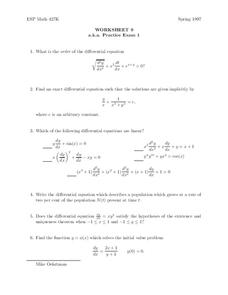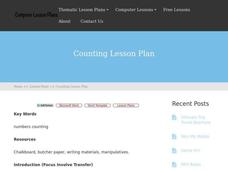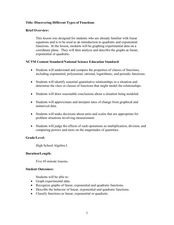Curated OER
Worksheet 4
In this math worksheet, learners write down five exact differential equations in symmetric form. Then they test the statements concerning differential equations.
Curated OER
Challenge Discussion Sheet 8
In this differential worksheet, students compute the rate a boat is approaching a dock when given the height and length of a rope. They find the rate the angle formed when a rocket is launched at given distances above the ground....
Curated OER
Worksheet 16
For this math worksheet, students consider a constant coefficient linear second order differential equation. Then they solve the homogeneous equation.
Curated OER
Worksheet 9 Practice Test 1
In this math worksheet, students find the solutions to the differential equations. Then they examine the group of equations in order to determine the ones that are linear.
Curated OER
Worksheet 3
in this math learning exercise, students define the meaning of a differential equation. Then they examine the method of solving a separable equation.
Curated OER
Worksheet 33 Spring 1996
In this math worksheet, learners find the solutions to the differential equations. Then they graph the solution and show if they are perpendicular.
Curated OER
Quiz 9: Newton's Method
In this Newton's method worksheet, students estimate the value of a solution and use a differential to estimate the value of a root. This one-page worksheet contains two problems.
Teachnology
Statistics & Probability with Cards
Give young mathematicians a chance to demonstrate their understanding of basic probability with this series of worksheets. Presented with different situations involving dice and decks of cards, students must correctly determine the...
Virginia Department of Education
The Real Meal Deal
Burgers and salads and sodas, oh my! Scholars use a menu to investigate the Fundamental Counting Principle. They create tree diagrams to illustrate the number of possible choices for each given scenario.
Curated OER
Counting Lesson Plan
In whole group practice, children count together and identify how many objects are drawn on butcher paper, increasing the number when they have achieved fluency. In pairs, they count manipulatives. They then copy series of numbers from...
Curated OER
Who Shares My Function? Linear with All Representations
Students investigate and interpret functions and graphs. In this algebra activity, students analyze equations, graphs and word problems to differentiate between quadratic functions and linear equations. They create a...
Curated OER
Contrasting Equations
Students investigate why a slopes using graphs. In this algebra lesson, students differentiate between negative and postive slopes by graphing. They collect data, write an equation and graph using the slope.
Curated OER
Who Shares My Function?
Students differentiate between linear and quadratic functions. For this algebra lesson, students write equations of graphs and graph a function from an equation. They also move the graph around on the coordinate plane.
Curated OER
Isosceles Triangle Theorem
In this geometry worksheet, students differentiate between regular triangles and isosceles triangles. They apply the converse theorem and the vertex angle. There are eleven questions with an answer key.
Curated OER
Isosceles Triangle Theorem
In this geometry worksheet, students differentiate between isosceles and regular triangles. They calculate the area and perimeter of the triangle. There are eleven questions with an answer key.
Curated OER
Discovering Different Types of Functions
Graph polynomials and identify the end behavior of each polynomial function. The class differentiates between linear, quadratic, and other polynomial equations.
Curated OER
Exploring Exponential Growth and Decay Functions
Students differentiate between exponential growth and decay. In this algebra instructional activity, students solve exponential equations using properties of exponents. They use the Ti calculator to graph and analyze their...
Curated OER
Soaring Towers
How tall can your tower get? Implement shapes, building strategies, teamwork, and prediction in this interactive tower activity. Learners discuss past experiences with stacking materials, recalling ways they kept it from falling over....
EngageNY
Using Sample Data to Estimate a Population Characteristic
How many of the pupils at your school think selling soda would be a good idea? Show learners how to develop a study to answer questions like these! The lesson explores the meaning of a population versus a sample and how to interpret the...
EduGAINs
Introduction to Solving Linear Systems
Word problems offer class members an opportunity to learn the concept of solving linear systems using graphs. Individuals choose a problem based upon preferences, break into groups to discuss solution methods and whether there...
Intel
Pedal Power
Show your classes the importance of mathematics in something as simple as bicycle design. The final lesson in the six-part STEM series has each group research a different aspect of the bicycle. Learners use mathematical formulas, linear...
College Board
2004 AP® Calculus AB Free-Response Questions
Develop a deeper understanding of calculus. The released item and support materials allows teachers and pupils to dig deeper into calculus topics. Scholars use the commentary and descriptions of the items to gain a better understanding...
College Board
2004 AP® Calculus AB Free-Response Questions Form B
The test is not all about skills. The six free-response questions contain two real-world application problems. Those items deal with populations and velocities. The other four questions ask pupils to show their knowledge of calculus...
Bowland
Football, the Beautiful Game
Discover how to use mathematics to make a stronger soccer team. Young soccer enthusiasts use given data to make decisions about a soccer team. They decide which position to assign each player, consider what makes a good pass and...

























